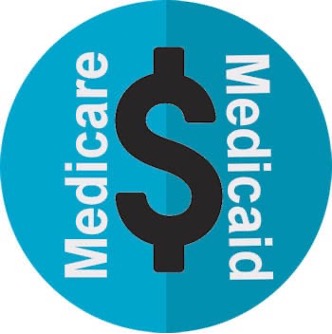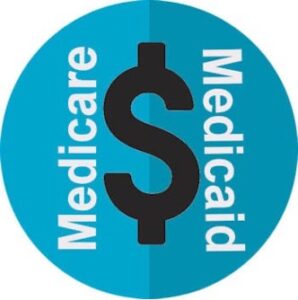They sound similar, but each serves different populations—though there can be some overlap.
Oct. 12, 2021 – By David Levine
Although they were born on the same day, Medicare and Medicaid are not identical twins. And even though they have been around for 55 years, many people still confuse these two government-backed health care programs.
On July 30, 1965, President Lyndon Johnson signed the laws that created Medicare and Medicaid as part of his Great Society programs to address poverty, inequality, hunger and education issues. Both Medicare and Medicaid offer health care support, but they do so in very different ways and mostly for different constituencies.

According to the Medicare Rights Center:
- Medicare is a federal program that provides health coverage to those age 65 and older, or to those under 65 who have a disability, with no regard to personal income.
- Medicaid is a combined state and federal program that provides health coverage to those who have a very low income, regardless of age.
Some people may be eligible for both Medicare and Medicaid, known as dually eligible, and can qualify for both programs. The two programs work together to provide health coverage and lower costs. And although Medicare and Medicaid are both health insurance programs administered by the government, there are differences in the services they cover and in the ways costs are shared.
Medicare Defined
Medicare is a federal health insurance program. According to the Department of Health and Human Services, the program pays medical bills from trust funds that working people have paid into during their employment. It offers essentially the same coverage and costs everywhere in the United States and is overseen by the Centers for Medicare & Medicaid Services, an agency of the federal government.
Medicare is designed primarily to serve people over 65, whatever their income, and younger disabled people and dialysis patients who are diagnosed with end-stage renal disease (permanent kidney failure requiring dialysis or transplant). Patients pay a portion of their medical costs through deductibles for hospital and other services. They also pay small monthly premiums for non-hospital coverage.
Medicare has two parts. Part A covers hospital care, and Part B covers other services like doctor’s appointments, outpatient treatment and other medical expenses. HHS says you are eligible for premium-free Part A if you are age 65 or older and you or your spouse worked and paid Medicare taxes for at least 10 years. You can get Part A at age 65 without having to pay premiums if:
- You receive retirement benefits or are eligible to receive benefits from Social Security or the Railroad Retirement Board.
- You or your spouse had Medicare-covered government employment.
If you are under age 65, you can get Part A without having to pay premiums if:
- You have been entitled to Social Security or Railroad Retirement Board disability benefits for 24 months.
- You are a kidney dialysis or kidney transplant patient.
HHS says that most people do not have to pay a premium for Part A, but everyone must pay a premium for Part B. This is deducted monthly from your Social Security, railroad retirement or Civil Service retirement check; those who do not get any of these payments are billed for their Part B premium every three months.
Prescription drugs are covered under Medicare Part D. Everyone with Medicare, regardless of income, health status or prescription drug usage, can obtain prescription drug coverage for a monthly premium.
While the federal government administers what’s known as Original Medicare, it is also possible to purchase Medicare plans from some private insurance companies. These plans are known as Medicare Advantage. These include Part A and Part B coverage, but may or may not include prescription drug coverage.
Medicaid Defined
Medicaid is a government assistance program administered by both the federal government and state governments. As such, its rules of coverage and cost vary from one state to another.
It serves low-income people, families and children, pregnant women, the elderly and people with disabilities of every age. Income levels are generally based on the federal poverty level, but each state can determine who qualifies and who doesn’t.
According to HHS, patients usually pay none of the costs for covered medical expenses or a small co-payment. Some states cover all low-income adults below a certain income level. Since the enactment of the Affordable Care Act, states have been allowed to expand their Medicaid programs to cover all people with household incomes below a certain level. Some states have done so, while others have not.
Whether you qualify for Medicaid coverage depends partly on whether your state has expanded its program. HHS says that, in states that have expanded Medicaid coverage, you can qualify for Medicaid if your household income is below 133% of the federal poverty level. Some states use a different income limit, however.
The Fine Print
Being government programs, both Medicare and Medicaid can be complicated, confusing and challenging to navigate for some people.
Once you turn 65 years old, Medicare automatically becomes your primary insurance payer, says Diane Omdahl, president and founder of 65Incorporated, a Medicare consulting firm. If you also qualify for Medicaid, that becomes your secondary payer. “It works like a supplement plan, picking up the costs that Medicare Part A and B don’t cover,” she says. However, she recommends talking to a consultant or a representative of your state health insurance assistance program, known as SHIP, for guidance. “Talk to someone about what needs to be done, because you can’t rest assured that it will be done automatically,” she says.
When picking a Medicare or Medicare Advantage plan, the choices can be overwhelming. How flexible is the coverage offered? Are your doctors included in the plan? Does it cover your needs for, say eye care or mental health care?






